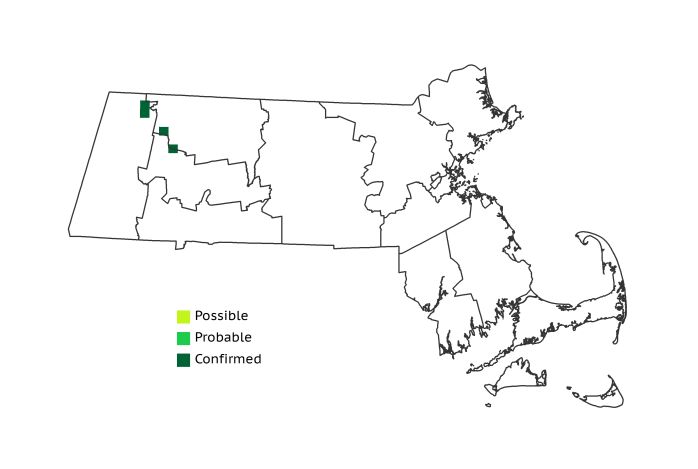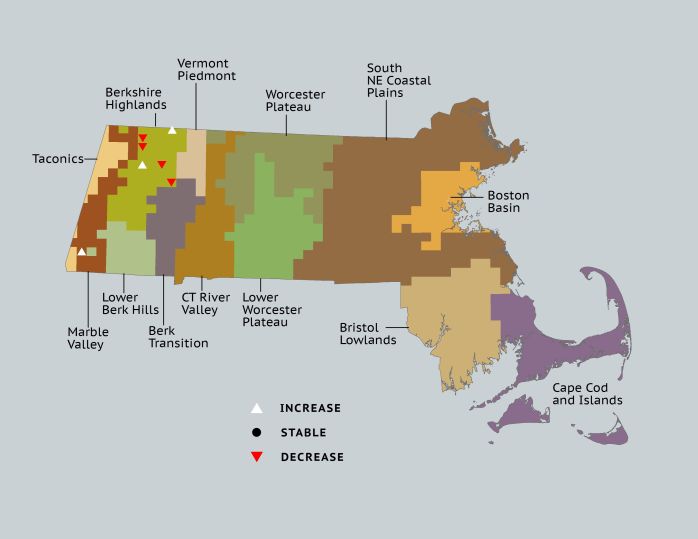Find a Bird
Rusty Blackbird
Euphagus carolinus

Very local, trend not established
“Pack up all my care and woe, / Here I go, singing low: / Bye, bye, blackbird.” Mort Dixon & Ray Henderson, “Bye Bye Blackbird”
The Rusty Blackbird – the rarest and most reclusive of our breeding blackbirds – is something of an oddball among its peers, eschewing fields and suburbs for the seclusion of forested bogs. The Rusty Blackbird is a marginal breeder in the Bay State, and the Atlas 2 results offer little hope that the species is expanding. Although national efforts are underway to better understand this species, at present the Rusty Blackbird is poorly known and very local as a breeder in Massachusetts.
Historic Status
The early story of the “Rusty Grackle” in Massachusetts is the same as the story of the Rusty Blackbird today. A breeder in the far north and a winterer in the south, Rusty Blackbirds passed through the state primarily on the way to and from their breeding and wintering grounds. “On their way north, they are in haste, having an immense distance to travel,” wrote William Peabody. “On their return, they are more deliberate, and are seen in the field in large flocks, keeping company with the cattle” (Peabody 1839), a trait that makes them sound like the Cow Buntings of old, which are today known as Brown-headed Cowbirds.
Atlas 1 Distribution
Confined entirely to the Berkshire Highlands as a breeding species, Rusty Blackbirds were nonetheless present and Confirmed at multiple sites in Atlas 1. Though the birds favored high-altitude out-of-the-way spruce bogs, intrepid Atlas volunteers were still able to find a few Rusty Blackbirds busy ensuring the future of the species. In fact, the first nest ever found of this species in Massachusetts was collected from a swamp in Savoy Mountain State Forest in 1977 during an Atlas 1 survey.
Atlas 2 Distribution and Change
Concern for this species has been amplified during the last 10 years, as wintering and breeding estimates seem to be crashing. While Massachusetts has never supported a robust breeding population of this species, even our existing fringe population seems to have been extirpated during the Atlas interval. There were only a few reports during Atlas 2, and none were Confirmed.
Atlas 1 Map

Atlas 2 Map

Atlas Change Map

Ecoregion Data
Atlas 1 | Atlas 2 | Change | ||||||
Ecoregion | # Blocks | % Blocks | % of Range | # Blocks | % Blocks | % of Range | Change in # Blocks | Change in % Blocks |
Taconic Mountains | 0 | 0.0 | 0.0 | 0 | 0.0 | 0.0 | 0 | 0.0 |
Marble Valleys/Housatonic Valley | 0 | 0.0 | 0.0 | 1 | 2.6 | 25.0 | 1 | 2.6 |
Berkshire Highlands | 4 | 7.3 | 100.0 | 2 | 3.6 | 50.0 | -2 | -3.8 |
Lower Berkshire Hills | 0 | 0.0 | 0.0 | 0 | 0.0 | 0.0 | 0 | 0.0 |
Vermont Piedmont | 0 | 0.0 | 0.0 | 0 | 0.0 | 0.0 | 0 | 0.0 |
Berkshire Transition | 0 | 0.0 | 0.0 | 0 | 0.0 | 0.0 | 0 | 0.0 |
Connecticut River Valley | 0 | 0.0 | 0.0 | 0 | 0.0 | 0.0 | 0 | 0.0 |
Worcester Plateau | 0 | 0.0 | 0.0 | 1 | 1.1 | 25.0 | 0 | 0.0 |
Lower Worcester Plateau | 0 | 0.0 | 0.0 | 0 | 0.0 | 0.0 | 0 | 0.0 |
S. New England Coastal Plains and Hills | 0 | 0.0 | 0.0 | 0 | 0.0 | 0.0 | 0 | 0.0 |
Boston Basin | 0 | 0.0 | 0.0 | 0 | 0.0 | 0.0 | 0 | 0.0 |
Bristol and Narragansett Lowlands | 0 | 0.0 | 0.0 | 0 | 0.0 | 0.0 | 0 | 0.0 |
Cape Cod and Islands | 0 | 0.0 | 0.0 | 0 | 0.0 | 0.0 | 0 | 0.0 |
Statewide Total | 4 | 0.4 | 100.0 | 4 | 0.4 | 100.0 | -1 | -0.1 |
Notes
The Rusty Blackbird shows a significant decreasing Breeding Bird Survey trend in the Eastern US overall.



